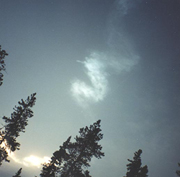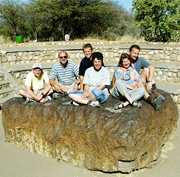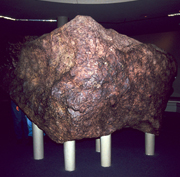Giants from space

Enlargement
Dust trail left by the passage of the stony meteoroid at Tagish Lake. A large part of the object vaporized as it passed through the Earth's atmosphere. |
Some meteorites are mainly made of stone and others, of metal. Stony meteorites are the most fragile. As they travel through the atmosphere, they are affected more by fragmentation and ablation. Up to 90% of the mass of a stony meteoroid may be vaporized. This is why stony meteorites have long and impressive dust tails. Once they reach the ground, there is generally a large number of pieces, and they are small in size. The table below presents the largest stony and stony-iron meteorites according to their total recovered mass.
The largest individual meteorite fragments found are irons, because these stand up much better to collisions in space and the stresses associated with passing through the atmosphere. They are all finds that struck the Earth thousands of years ago. The largest meteorite fragment ever discovered is the Hoba. It weighs 60 metric tons, which is equivalent to the weight of eight school buses! This meteorite still lies in the same place it landed. The largest iron meteorite fragments discovered are listed in the following table.
| THE LARGEST METEORITES |
| Iron (individual fragments) |
| Name |
Country |
Mass |
| Hoba |
Namibia |
60 metric tons |
| Campo del Cielo |
Argentina |
37 metric tons |
| Cape York |
Greenland |
31 metric tons |
| Stony-iron (total mass) |
| Name |
Country |
Mass |
| Vaca Muerta |
Chile |
3.3 metric tons |
| Brenham |
United States |
3 metric tons |
| Huckitta |
Australia |
1.4 metric tons |
| Stony (total mass) |
| Name |
Country |
Mass |
| Jilin |
China |
4 metric tons |
| Allende |
Mexico |
2 metric tons |
| Tsarev |
Russia |
1.2 metric tons |
 |
| Enlargement |
| The discovery site of the Hoba meteorite has been made attractive for visitors who want to touch and climb on the largest meteorite on Earth. |
 |
| Enlargement |
| Ahnighito, the biggest fragment of the Cape York meteorite, weighs 31 metric tons. The posts supporting it descend right down to the rock under the building. |
|